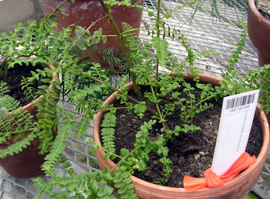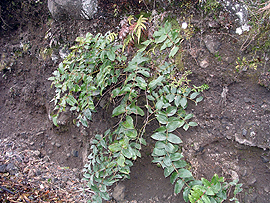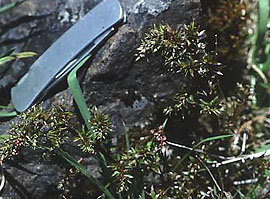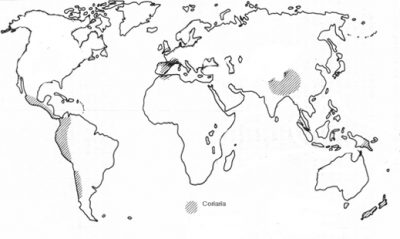

Coriaria ruscifolia v.microphylla L.
Coriaria nepalensis Wallich.


Coriaria arborea New Zealand (W. Silvester)
Coriaria plumosa, Mt. Cook, New Zealand (D. Benson)
Coriariaceae Species |
||
| C. japonica A. Gray C. kingiana Col. C. arborea C. myrtifolia L. |
C. nepalensis Wallich C. plumosa W.R.B. Oliver C. pottsiana W.R.B. Oliver C. pteroides T. Kirk |
C. ruscifolia L. C. sarmentosa Forst. f. C. terminalis Hemsl. C. thymifolia Humb. & Bonpl. |
(Ecology of the Coriaria symbioses)
The Coriariaceae has been placed within the Cucurbitales (APG, 1998). Coriaria has between 5 and 20 species depending on the particular classification (Yokoyama et al., 2000). The genus has a remarkable geographic distribution. It is found in the Mediterranean, Southeast Asia, Central and South America, and the Pacific islands of New Zealand and Papua New Guinea (Fig. 2; Skog, 1972). This geographic disjunction has led to several hypotheses concerning its origin and diversification. Yokoyama et al. (2000) found that the basal members of the genus are found in Asia and Central America, suggesting that the origin of genus was in either Eurasia or North America. The authors further suggested that the genus originated some 60 Mybp, far older than an estimate of 5-11 Mybp based on fossil evidence.

Fig. 2. Disjunct distribution of Coriaria sp. (Redrawn from Silvester (1977)
Coriaria displays two main clades. Clade I consists of taxa from the Mediterranean and Asia and clade II consists of taxa from Central and South America. Simple vicariance and dispersal caused by glaciation and drying during the Cenozoic may account for the distribution of Coriaria in clade I, but cannot explain the distribution of the Coriaria species present in clade II. The topology of clade II suggests long distance dispersal from Central America to the Pacific islands, followed by another migration back to South America (Chile).
Nodules have been observed on Coriaria species from New Zealand (C. arborea, C. plumosa, C. sarmentosa, C. angustissima, C. pottsiana ), from Central America (C. microphylla), Europe (C. myrtifolia) and Central Asia (C. nepalensis) (Mirza, et al., 1994; Nick et al., 1992; Silvester, 1977). The total number of Coriaria spp. able to nodulate has yet to be determined. However, at least one species from all four major zones of diversity nodulates, and known nodulating species are present in both clade I and clade II, indicating that the association with Frankia strains appears to be widespread throughout the genus. The distribution of Coriaria strains in soils devoid of Coriaria hosts has not been addressed. Some studies in New Zealand indicate that Coriaria arborea plants are nodulated wherever planted and will readily nodulate in new volcanic soils.